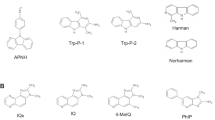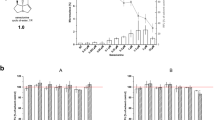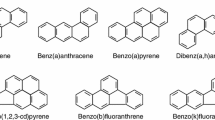Abstract
Heterocyclic aromatic amines (HCAs) are compounds formed when meat or fish are cooked at high temperatures for a long time or over an open fire. To determine which pathways of toxicity are activated by HCAs, nine out of the ten HCAs known to be carcinogenic in rodents (2-amino-9H-pyrido[2,3-b]indole (AαC), 2-aminodipyrido[1,2-a:3′,2-d]imidazole (Glu-P-2), 2-amino-3-methylimidazo[4,5-f]quinoline (IQ), 2-amino-3-methyl-9H-pyrido[2,3-b]indole (MeAαC), 2-amino-3,4-dimethylimidazo[4,5-f]quinoline (MeIQ), 2-amino-3,8-dimethylimidazo[4,5-f]quinoxaline (MeIQx), 2-amino-1-methyl-6-phenylimidazo[4,5-b]pyridine (PhIP), 3-amino-1,4-dimethyl-5H-pyrido[4,3-b]indole (Trp-P-1), and 3-amino-1-methyl-5H-pyrido[4,3-b]indole (Trp-P-2)) were tested in the estrogen receptor α (ERα), androgen receptor (AR), glucocorticoid receptor (GR), peroxisome proliferator-activated receptor γ2 (PPARγ2), polycyclic aromatic hydrocarbons (PAH), Nrf2, and p53 CALUX® reporter gene assays. Trp-P-1 was the only HCA that led to a positive response in the ERα, PPARγ2, and Nrf2 CALUX® assays. In the PAH CALUX® assay, Trp-P-2, MeAαC, and AαC induced luciferase activity to a greater extent than MeIQ and PhIP. In the p53 CALUX® assay without a coupled metabolic activation, only Trp-P-1 and Trp-P-2 enhanced luciferase expression; when a metabolic activation step was coupled to the p53 CALUX® assay, Trp-P-1, Glu-P-2, MeIQ, MeIQx, and PhIP induced a positive response. No HCA was positive in the AR and GR CALUX® assays. Taken together, the results obtained show that the battery of CALUX® assays performed in the present study can successfully be used to screen for molecular cell targets of carcinogenic compounds such as HCAs.


Similar content being viewed by others
Abbreviations
- AαC:
-
2-Amino-9H-pyrido[2,3-b]indole
- BCRP:
-
Breast cancer resistance protein
- Glu-P-2:
-
2-Aminodipyrido[1,2-a:3′,2-d]imidazole
- HCAs:
-
Heterocyclic aromatic amines
- IQ:
-
2-Amino-3-methylimidazo[4,5-f]quinoline
- MeAαC:
-
2-Amino-3-methyl-9H-pyrido[2,3-b]indole
- MeIQ:
-
2-Amino-3,4-dimethylimidazo[4,5-f]quinoline
- MeIQx:
-
2-Amino-3,8-dimethylimidazo[4,5-f]quinoxaline
- PhIP:
-
2-Amino-1-methyl-6-phenylimidazo[4,5-b]pyridine
- Trp-P-1:
-
3-Amino-1,4-dimethyl-5H-pyrido[4,3-b]indole
- Trp-P-2:
-
3-Amino-1-methyl-5H-pyrido[4,3-b]indole
References
Aeschbacher H-U, Turesky RJ. Mammalian cell mutagenicity and metabolism of heterocyclic aromatic amines. Mutat Res. 1991;259:235–50.
Ashida H, Kihara K, Shiotani B, Hashimoto T, Kanazawa K, Danno G. Detection of biomarkers for apoptosis in rat liver after perfusion with 3-amino-1,4-dimethyl-5H-pyrido[4,3-b]indole (Trp-P-1). Biosci Biotechnol Biochem. 2000;64:2021–4.
Ashida H, Kihara K, Nonaka Y, Fukuda I, Shiotani B, Hashimoto T. The heterocyclic amine 3-amino-1,4-dimethyl-5H-pyrido[4,3-b]indole induces apoptosis in cocultures of rat parenchymal and nonparenchymal liver cells. Toxicol Appl Pharmacol. 2001;177:59–67.
Beck M, Schmidt A, Malmstroem J, Claassen M, Ori A, Szymborska A, Herzog F, Rinner O, Ellenberg J, Aebersold R. The quantitative proteome of a human cell line. Mol Syst Biol. 2011;7:1–8.
Bekki K, Takigami H, Suzuki G, Tang N, Hayakawa K. Evaluation of toxic activities of polycyclic aromatic hydrocarbon derivatives using in vitro bioassays. J Health Sci. 2009;55:601–10.
Bovee TFH, Helsdingen RJR, Hamers ARM, Brouwer BA, Nielen MWF. Recombinant cell bioassays for the detection of (gluco)corticosteroids and endocrine-disrupting potencies of several environmental PCB contaminants. Anal Biochem Chem. 2011;401:873–82.
Bovee TFH, Heskamp HH, Helsdingen RJR, Hamers ARM, Brouwer BA, Nielen MWF. Validation of a recombinant cell bioassay for the detection of (gluco)corticosteroids in feed. Food Addit Contam. 2013;30:264–71.
Burnouf DY, Miturski R, Nagao M, Nakagama H, Nothisen M, Wagner J, Fuchs RPP. Early detection of 2-amino-1-methyl-6-phenylimidazo[4,5-b]pyridine (PhIP)-induced mutations within the Apc gene of rat colon. Carcinogenesis. 2001;22:329–35.
Cerec V, Glaise D, Garnier D, Morosan S, Turlin B, Drenou B, Gripon P, Kremsdorf D, Guguen-Guillouzo C, Corlu A. Transdifferentiation of hepatocyte-like cells from the human hepatoma HepaRG cell line through bipotent progenitor. Hepatology. 2007;45:957–67.
Creton SK, Zhu H, Gooderham NJ. The cooked meat carcinogen 2-amino-1-methyl-6-phenylimidazo[4,5-b]pyridine activates the extracellular signal-regulated kinase mitogen-activated protein kinase pathway. Cancer Res. 2007;67:11455–62.
Dashwood RH, Suzui M, Nakagama H, Sugimura T, Nagao M. High frequency of β-catenin (ctnnb1) mutations in the colon tumors induced by two heterocyclic amines in the F344 rat. Cancer Res. 1998;58:1127–9.
Degawa M, Tanimura S, Agatsuma T, Hashimoto Y. Hepatocarcinogenic heterocyclic aromatic amines that induce cytochrome P-448 isozymes, mainly cytochrome P-448H (P-450IA2), responsible for mutagenic activation of the carcinogens in rat liver. Carcinogenesis. 1989;10:1119–22.
DEMEAU. Selection criteria to select in vitro bioassays for implementation and use. 2015. http://demeau-fp7.eu/content/d411-selection-criteria-select-vitro-bioassays-implementation-and-use.
Dragsted LO, Frandsen H, Reistad R, Alexander J, Larsen JC. DNA-binding and disposition of 2-amino-1-methyl-6-phenylimidazo[4,5-b]pyridine (PhIP) in the rat. Carcinogenesis. 1995;16:2785–93.
Dumont J, Jossé R, Lambert C, Anthérieu S, Laurent V, Loyer P, Robin MA, Guillouzo A. Preferential induction of the AhR gene battery in HepaRG cells after a single or repeated exposure to heterocyclic aromatic amines. Toxicol Appl Pharmacol. 2010;249:91–100.
Escher P, Braissant O, Basu-Modak S, Michalik L, Wahli W, Desvergne B. Rat PPARs: quantitative analysis in adult rat tissues and regulation in fasting and refeeding. Endocrinology. 2001;142:4195–202.
Esumi H, Ohgaki H, Kohzen E, Takayama S, Sugimura T. Induction of lymphoma in CDF1 mice by the food mutagen, 2-amino-1-methyl-6-phenylimidazo[4,5-b]pyridine. Jpn J Cancer Res. 1989;80:1176–8.
Frandsen H, Grivas S, Andersson R, Dragsted L, Larsen JC. Reaction of the N 2-acetoxy derivative of 2-amino-1-methyl-6-phenylimidazo[4,5-b]pyridine (PhIP) with 2′-deoxyguanosine and DNA. Synthesis and identification of N 2-(2′-deoxyguanosin-8-yl)-PhIP. Carcinogenesis. 1992;13:629–35.
Friesen MD, Kaderlik K, Lin D, Garren L, Bartsch H, Lang NP, Kadlubar FF. Analysis of DNA adducts of 2-amino-1-methyl-6-phenylimidazo[4,5-b]pyridine in rat and human tissues by alkaline hydrolysis and gas chromatography/electron capture mass spectrometry: validation by comparison with 32P-postlabeling. Chem Res Toxicol. 1994;7:733–9.
Geiger T, Wehner A, Schaab C, Cox J, Mann M. Comparative proteomic analysis of eleven common cell lines reveals ubiquitous but varying expression of most proteins. Mol Cell Proteomics. 2012;11:1–11.
Gijsbers L, Man H, Kloet SK, de Haan LHJ, Keijer J, Rietjens IMCM, van der Burg B, Aarts JMMJG. Stable reporter cell lines for peroxisome proliferator-activated receptor γ (PPARγ)-mediated modulation of gene expression. Anal Biochem. 2011;414:77–83.
Gooderham NJ, Zhu H, Lauber S, Boyce A, Creton S. Molecular and genetic toxicology of 2-amino-1-methyl-6-phenylimidazo[4,5-b]pyridine (PhIP). Mutat Res. 2002;506-507:91–9.
Gooderham NJ, Creton S, Lauber SN, Zhu H. Mechanisms of action of the carcinogenic heterocyclic aromatic amine PhIP. Toxicol Lett. 2007;168:269–77.
Gripon P, Rumin S, Urban S, Le Seyec J, Glaise D, Cannie I, Guyomard C, Lucas J, Trepo C, Guguen-Guillouzo C. Infection of a human hepatoma cell line by hepatitis B virus. Proc Natl Acad Sci U S A. 2002;99:15655–60.
Heringa M, van der Linden SC, Schriks M, van der Burg B, van Wezel AP. Use of effect-directed assays in assessing the quality of drinking water and its sources. In: van den Hoven T, Kazner C, editors. TECHNEAU: safe drinking water from source to tap—state of the art & perspectives. London: IWA Publishing; 2009. p. 173–83.
Ito N, Hasegawa R, Sano M, Tamano S, Esumi H, Takayama S, Sugimura T. A new colon and mammary carcinogen in cooked food, 2-amino-1-methyl-6-phenylimidazo[4,5-b]pyridine (PhIP). Carcinogenesis. 1991;12:1503–6.
Kakiuchi H, Watanabe M, Ushijima T, Toyota M, Imai K, Weisburger JH, Sugimura T, Nagao M. Specific 5′-GGGA-3′ → 5′-GGA-3′ mutation of the Apc gene in rat colon tumors induced by 2-amino-1-methyl-6-phenylimidazo[4,5-b]pyridine. Proc Natl Acad Sci U S A. 1995;92:910–4.
Kato N, Ohgaki H, Hasegawa H, Sato S, Takayama S, Sugimura T. Carcinogenicity in rats of a mutagenic compound, 2-amino-3,8-dimethylimidazo[4,5-f]quinoxaline. Carcinogenesis. 1988;9:71–3.
Kienle C, Kase R, Werner I. Evaluation of bioassays and wastewater quality. In: In vitro and in vivo bioassays for the performance review in the Project “Strategy MicroPoll”. Duebendorf: Swiss Centre for Applied Ecotoxicology, Eawag-EPFL; 2011: 1–71.
Kitamura Y, Umemura T, Kanki K, Kodama Y, Kitamoto S, Saito K, Itoh K, Yamamoto M, Masegi T, Nishikawa A, Hirose M. Increased susceptibility to hepatocarcinogenicity of Nrf2-deficient mice exposed to 2-amino-3-methylimidazo[4,5-f]quinoline. Cancer Sci. 2007;98:19–24.
Kleman M, Gustafsson J-Å. Interactions of procarcinogenic heterocyclic aromatic amines and indolocarbazoles with the dioxin receptor. Biol Chem. 1996;377:741–62.
Kleman M, Övervik E, Mason G, Gustafsson J-Å. Effects of the food mutagens MeIQx and PhIP on the expression of cytochrome P450IA proteins in various tissues of male and female rats. Carcinogenesis. 1990;11:2185–9.
Kleman M, Övervik E, Mason GGF, Gustafsson J-Å. In vitro activation of the dioxin receptor to a DNA-binding form by food-borne heterocyclic amines. Carcinogenesis. 1992;13:1619–24.
Kuhn K, Nowak B, Behnke A, Seidel A, Lampen A. Effect-based and chemical analysis of polycyclic aromatic hydrocarbons in smoked meat: a practical food-monitoring approach. Food Addit Contam. 2009;26:1104–12.
Lauber SN, Gooderham NJ. The cooked meat-derived genotoxic carcinogen 2-amino-3-methylimidazo[4,5-b]pyridine has potent hormone-like activity: mechanistic support for a role in breast cancer. Cancer Res. 2007;67:9597–602.
Lauber SN, Ali S, Gooderham NJ. The cooked food derived carcinogen 2-amino-1-methyl-6-phenylimidazo[4,5-b]pyridine is a potent oestrogen: a mechanistic basis for its tissue-specific carcinogenicity. Carcinogenesis. 2004;25:2509–17.
Leusch FDL. Tools to detect estrogenic activity in environmental waters. London: Global Water Research Coalition; 2008. p. 1–86.
Matsukura N, Kawachi T, Morino K, Ohgaki H, Sugimura T, Takayama S. Carcinogenicity in mice of mutagenic compounds from a tryptophan pyrolyzate. Science. 1981;213:346–7.
Michalik L, Desvergne B, Wahli W. Peroxisome-proliferator-activated receptors and cancers: complex stories. Nat Rev Cancer. 2004;4:61–70.
Ohgaki H, Matsukura N, Morino K, Kawachi T, Sugimura T, Takayama S. Carcinogenicity in mice of mutagenic compounds from glutamic acid and soybean globulin pyrolysates. Carcinogenesis. 1984;5:815–9.
Ohgaki H, Hasegawa H, Kato T, Suenaga M, Sato S, Takayama S, Sugimura T. Carcinogenicities in mice and rats of IQ, MeIQ, and MeIQx. Princess Takamatsu Symp. 1985;16:97–105.
Ohgaki H, Hasegawa H, Kato T, Suenaga M, Ubukata M, Sato S, Takayama S, Sugimura T. Carcinogenicity in mice and rats of heterocyclic amines in cooked foods. Environ Health Perspect. 1986;67:129–34.
Ohgaki H, Hasegawa H, Suenaga M, Sato S, Takayama S, Sugimura T. Carcinogenicity in mice of a mutagenic compound, 2-amino-3,8-dimethylimidazo [4,5-f]quinoxaline (MeIQx) from cooked foods. Carcinogenesis. 1987;8:665–8.
Omiecinski CJ, Vanden Heuvel JP, Perdew GH, Peters JM. Xenobiotic metabolism, disposition, and regulation by receptors: from biochemical phenomenon to predictors of major toxicities. Toxicol Sci. 2011;120(S1):S49–75.
Peraza MA, Burdick AD, Marin HE, Gonzalez FJ, Peters JM. The toxicology of ligands for peroxisome proliferator-activated receptors (PPAR). Toxicol Sci. 2006;90:269–95.
Pieterse B, Felzel E, Winter R, van der Burg B, Brouwer A. PAH-CALUX, an optimized bioassay for carcinogenic hazard identification of polycyclic aromatic hydrocarbons (PAHs) as individual compounds and in complex mixtures. Environ Sci Technol. 2013;47:11651–9.
Qiu C, Shan L, Yu M, Snyderwine EG. Deregulation of the cyclin D1/Cdk4 retinoblastoma pathway in rat mammary gland carcinomas induced by the food-derived carcinogen 2-amino-1-methyl-6-phenylimidazo[4,5-b]pyridine. Cancer Res. 2003;63:5674–8.
Rushmore TH, Morton MR, Pickett CB. The antioxidant responsive element. Activation by oxidative stress and identification of the DNA consensus sequence required for functional activity. J Biol Chem. 1991;266:11632–9.
Schut HA, Herzog CR. Formation of DNA adducts of 2-amino-1-methyl-6-phenylimidazo[4,5-b]pyridine (PhIP) in male Fischer-344 rats. Cancer Lett. 1992;67:117–24.
Shiotani B, Nonaka Y, Hashimoto T, Kihara K, Kanazawa K, Danno G, Ashida H. DNA-damaging carcinogen 3-amino-1,4-dimethyl-5H-pyrido[4,3-b]indole (Trp-P-1) induces apoptosis via caspase-9 in primary cultured rat hepatocytes. Carcinogenesis. 2001;22:693–700.
SKLM. Heterocyclische aromatische amine. Statement of the Permanent Senate Commission on Food Safety of the German Research Foundation. 1998; http://www.dfg.de/download/pdf/dfg_im_profil/reden_stellungnahmen/download/p18haa.pdf
Sonneveld E, Jansen HJ, Riteco JAC, Brouwer A, van der Burg B. Development of androgen- and estrogen-responsive bioassays, members of a panel of human cell line-based highly selective steroid responsive bioassays. Toxicol Sci. 2005;83:136–48.
Steinberg P. High-throughput screening methods in toxicity testing. Hoboken: John Wiley & Sons; 2013.
Sugimura T. Overview of carcinogenic heterocyclic amines. Mutat Res. 1997;376:211–9.
Sugimura T, Wakabayashi K, Nakagama H, Nagao M. Heterocyclic amines: mutagens/carcinogens produced during cooking of meat and fish. Cancer Sci. 2004;95:290–9.
Takahashi M, Toyoda K, Aze Y, Furuta K, Mitsumori K, Hayashi Y. The rat urinary bladder as a new target of heterocyclic amine carcinogenicity: tumor induction by 3-amino-1-methyl-5H-pyrido[4,3-b]indole acetate. Jpn J Cancer Res. 1993;84:852–8.
Takayama S, Nakatsuru Y, Ohgaki H, Sato S, Sugimura T. Carcinogenicity in rats of a mutagenic compound, 3-amino-1,4-dimethyl-5H-pyrido[4,3-b]indole, from tryptophan pyrolysate. Jpn J Cancer Res. 1985;76:815–7.
Tamano S, Hasegawa R, Hagiwara A, Nagao M, Sugimura T, Ito N. Carcinogenicity of a mutagenic compound from food, 2-amino-3-methyl-9H-pyrido[2,3-b]indole (MeAαC), in male F344 rats. Carcinogenesis. 1994;15:2009–15.
Thompson LH, Tucker JD, Stewart SA, Christensen ML, Salazar EP, Carrano AV, Felton JS. Genotoxicity of compounds from cooked beef in repair-deficient CHO cells versus Salmonella mutagenicity. Mutagenesis. 1987;2:483–7.
Tontonoz P, Spiegelman BM. Fat and beyond: the diverse biology of PPARγ. Annu Rev Biochem. 2008;77:289–312.
Ubagai T, Ochiai M, Kawamori T, Imai H, Sugimura T, Nagao M, Nakagama H. Efficient induction of rat large intestinal tumors with a new spectrum of mutations by intermittent administration of 2-amino-1-methyl-6-phenylimidazo[4,5-b]pyridine in combination with a high fat diet. Carcinogenesis. 2002;23:197–200.
van der Burg B, Winter R, Weimer M, Berckmans P, Suzuki G, Gijsberg L, Jonas A, van der Linden S, Witters H, Aarts J, Legler J, Kopp-Schneider A, Bremer S. Optimization and prevalidation of the in vitro ERα CALUX method to test estrogenic and antiestrogenic activity of compounds. Reprod Toxicol. 2010a;30:73–80.
van der Burg B, Winter R, Man H, Vangenechten C, Berckmans P, Weimer M, Witters H, van der Linden S. Optimization and prevalidation of the in vitro AR CALUX method to test androgenic and antiandrogenic activity of compounds. Reprod Toxicol. 2010b;30:18–24.
van der Burg B, van der Linden S, Man H, Winter R, Jonker L, van Vugt-Lussenburg B, Brouwer A. A panel of quantitative CALUX® reporter gene assays for reliable high-throughput toxicity screening of chemicals and complex mixtures. In: Steinberg P, editor. High-throughput screening methods in toxicity testing. Hoboken: John Wiley & Sons; 2013. p. 519–32.
van der Linden SC, Heringa MB, Man H, Sonneveld E, Puijker LM, van der Burg B. Detection of multiple hormonal activities in wastewater effluents and surface water, using a panel of steroid receptor CALUX bioassays. Environ Sci Technol. 2008;42:5814–20.
van der Linden SC, von Bergh ARM, van Vugt-Lussenburg B, Jonker L, Brouwer A, Teunis M, Krul CA, van der Burg B. Development of a panel of high throughput reporter gene assays to detect genotoxicity and oxidative stress. Mutat Res. 2014;760:23–32.
van Vugt-Lussenburg B, Besseling HT, van der Burg B, Brouwer A. DR-Calux®: a high-throughput screening assay for the detection of dioxin and dioxin-like compounds in food and feed. In: Steinberg P, editor. High-throughput screening methods in toxicity testing. Hoboken: John Wiley & Sons; 2013. p. 533–46.
Wilson TM, Lambert MH, Kliewer SA. Peroxisome proliferator-activated receptor γ and metabolic disease. Annu Rev Biochem. 2001;70:341–67.
Wu KC, Cui JY, Klaassen CD. Effect of graded Nrf2 activation on phase-I and -II drug metabolizing enzymes and transporters in mouse liver. PLoS One. 2012;7:e39006.
Yu M, Snyderwine EG. H-ras oncogene mutations during development of 2-amino-1-methyl-6-phenylimidazo[4,5-b]pyridine (PhIP)-induced rat mammary gland cancer. Carcinogenesis. 2002;23:2123–8.
Yun C-H, Chung DK, Yoon K, Han SH. Involvement of reactive oxygen species in the immunosuppressive effect of 3-amino-1,4-dimethyl-5H-pyrido[4,3-b]indole (Trp-P-1), a food-born carcinogenic heterocyclic amine. Toxicol Lett. 2006a;161:37–43.
Yun C-H, Jung U, Son CG, Ju HR, Han SH. 3-Amino-1,4-dimethyl-5H-pyrido[4,3-b]indole (Trp-P-1), a food-born carcinogenic heterocyclic amine, promotes nitric oxide production in murine macrophages. Toxicol Lett. 2006b;161:18–26.
Author information
Authors and Affiliations
Corresponding author
Ethics declarations
Conflict of interest
The authors declare that they have no conflict of interest.
Rights and permissions
About this article
Cite this article
Steinberg, P., Behnisch, P.A., Besselink, H. et al. Screening of molecular cell targets for carcinogenic heterocyclic aromatic amines by using CALUX® reporter gene assays. Cell Biol Toxicol 33, 283–293 (2017). https://doi.org/10.1007/s10565-016-9373-6
Received:
Accepted:
Published:
Issue Date:
DOI: https://doi.org/10.1007/s10565-016-9373-6




